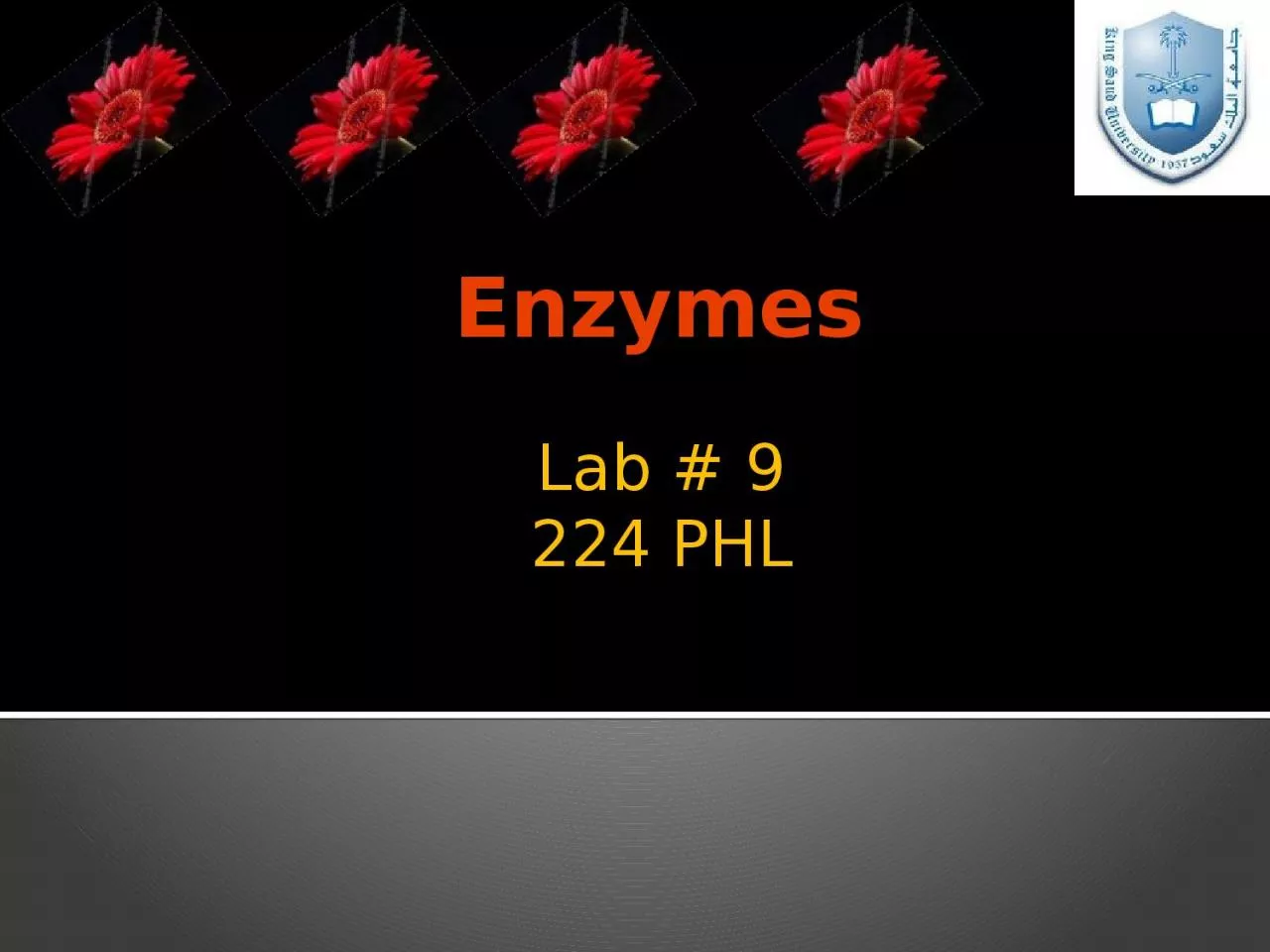

Phosphatases Activity Phosphatases are enzymes which catalyze the splitting of phosphoric acid from monophosphate esters They are hydrolases Organic phosphate esters water alcohol phosphate ID: 918493
Download Presentation The PPT/PDF document "Enzymes Lab # 9 224 PHL Determination of..." is the property of its rightful owner. Permission is granted to download and print the materials on this web site for personal, non-commercial use only, and to display it on your personal computer provided you do not modify the materials and that you retain all copyright notices contained in the materials. By downloading content from our website, you accept the terms of this agreement.
Slide1
Enzymes
Lab # 9224 PHL
Slide2Determination of Serum
Phosphatases Activity
Phosphatases are enzymes which catalyze the splitting of phosphoric acid from mono-phosphate esters.
They are hydrolases.Organic phosphate esters + water alcohol + phosphate ion
Two types are commonly estimated in the serum :Alkaline phosphatase with maximum activity at pH10
. Acid phosphatase with maximum activity at pH5.
Slide31)Determination
of Serum Alkaline Phosphatase (ALP ) Activity : Occurrence:
in most tissues of the body, mainly in:Osteoblasts in bone
.Bile canaliculi in liver .Small intestinal epithelium .
Proximal tubules of kidney.Breasts during lactation .In all these sites ALP seems to be involved in transport of phosphates across cell membranes.
Slide4ALP
is activated by Mg+2, Mn+2,Co+2
.ALP is inactivated by Zn
+2,Cu+2,Hg+2,EDTA.
Slide5Principle:
P-nitrophenylphosphate + H2O ALP
Phosphate + p-nitrophenol.
Slide6Procedure:
Pipette in to clean dry test tube 1 ml from working reagent
Put the test tube in the 37⁰C water bath “beaker”
Add 0.2 ml from the sample
Mix and put in the cuvette , and wait for 30 secondRecord the absorbance at
λ= 405 nm every 1 minute interval for 3 minutes The absorbance of the sample: A⁰
, A
1
, A
2, and A
3
.
Slide7Calculation:
The ALP activity (U/L) = (∆ A / min.) X 2720 = (A
⁰ - A1)+ (A1 - A2
)+ (A2 - A3)/3 X 2720
Normal value: 98 – 279 U/L
Slide8Clinical significance:
Increase in ALP occurs mainly in
: 1)
Bone diseases like Paget’s disease (highest level), rickets, hyperparathyroidism, bone cancer.2) Liver diseases like obstructive jaundice, biliary
cirrhosis, carcinoma liver abscess.3) Drugs producing cholestasis
like androgens, sulfonamides. or hepatotoxic drugs like aspirin, gentamycin,
cyclophosphamide
, and halothane .
Decrease in ALP occurs in: anemia, scurvy, and cretinism.
Slide92-Determination of Serum Acid
phosphatase (ACP )Activity :
Occurrence: The highest concentration of ACP is found in prostate
(prostatic ACP), also in RBCs, leucocytes and platelets (non prostatic ACP). ACP has a maximum activity at pH5.6
Slide10A variety of substrates have been used for determination of serum ACP activity . These include:
Nitrophenylphosphate-attacked by phosphatases of non-prostatic origin.
Β-Glycerophosphate, α
naphthylphosphate, phenolphthalein monophosphate are all non specific substrates for both.
Prostatic Acid Phosphatase is obtained by subtracting the results of the Non-Prostatic Acid Phosphatase assay from the results of the Total Acid
Phosphatase assay on the same sample.
Slide112-Determination of Serum Acid
phosphatase (ACP )Activity :
Principle:(ACP)1-naphthyl phosphate + H2O ACP
Phosphate + 1- naphthol1-naphthol + 4-chloro-2-methylphenyldiazonium salt Azo dye.
Slide122-Determination of Serum Acid
phosphatase (ACP )Activity :
a)Determination of Serum Total Acid phosphatase
Activity.b)Determination of Serum Non-Prostatic Acid phosphatase Activity
Slide13Procedure (Total ACP):
Pipette in to clean dry test tube 1 ml from working reagent
(R2A)
Put the test tube in the 37⁰C water bath “beaker”
Add 0.1 ml from the sample , Mix and incubate for 5 minute at water bathPut in the
cuvette Record the absorbance at λ= 405 nm every 1 minute interval for 3 minutes
The absorbance
of the sample: A
⁰
, A
1
, A
2
, and A
3
.
Slide14Procedure (Non-prostatic ACP):
Pipette in to clean dry test tube 1 ml from working reagent
(R2B)
Put the test tube in the 37⁰C water bath “beaker”
Add 0.1 ml from the sample , Mix and incubate for 5 minute at water bathPut in the
cuvette Record the absorbance at λ= 405 nm every 1 minute interval for 3 minutes
The absorbance
of the sample: A
⁰
, A
1
, A
2
, and A
3
.
Slide15Calculation:
Total ACP activity (U/L) = (∆ A / min.) X 743 = (A
⁰ - A1)+ (A1 - A
2)+ (A2 - A3)/3 X 743
Non-prostatic ACP activity (U/L) = (∆ A / min.) X 743 = (A⁰ - A1)+ (A
1 - A2)+ (A2 - A3
)/3 X 743
Prostatic ACP activity (U/L)
= Total ACP activity - Non-prostatic ACP activity .
Slide16Normal
value:Total ACP Up to 4.7 U/L.
Prostatic ACP Up to 1.6 U/L.
Slide17Clinical Significance:
Prostatic ACP is used mostly to detect prostatic carcinoma when it may reach very high level. In benign hypertrophy of prostate ACP is normal.
Slide18POP QUIZ
Slide191- An enzyme that transfer a group from one organic compound to another is called:
a) Lipase
b)
Aminotransferase
c) Decarboxylase
Slide202- An enzyme that convert one pair of isomers into another is called:
a)
Racemase
b) Pepsin
c) Ligase
Slide213- International unit (IU) is the amount of an enzyme that will
convert:
a) one
milli-mole of substrate per minute in an assay system b) one micro-mole of substrate per second in an assay
system
c) one micro-mole of substrate per minute in an assay system